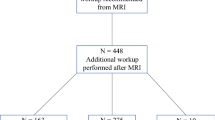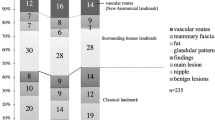Abstract
Introduction
Suspicious lesions on breast MRI are often initially evaluated using targeted ultrasound. However, workup varies. Data on the rate of correlate detection by morphology [mass, non-mass enhancement (NME), or focus] would be useful for developing practice guidelines.
Materials and methods
Breast MRI examinations from 1 January 2008 to 31 December 2010 were reviewed. BI-RADS 4 or 5 lesions on MRI evaluated with targeted ultrasound where definitive diagnosis was obtained were included. Statistical analysis was performed on aggregate data and at the lesion level.
Results
A total of 204 lesions were included in the study. A statistically significant difference in ultrasound correlate identification by morphology was found; a correlate was found in 49.3 % of masses, 15 % of NME, and 42.3 % of foci (p = 0.0006). Additional analysis within each morphology demonstrated significantly greater rate of malignancy in masses with an ultrasound correlate than masses without a correlate (p = 0.0062), while the rate of malignancy in NME and foci did not differ with ultrasound correlation.
Conclusions
Morphology of a suspicious lesion on breast MRI affects the probability of identifying an ultrasound correlate. As sonographic correlates are found in nearly half of masses and foci, targeted ultrasound should be the initial step in their workup.
Key Points
• Lesion morphology on breast MRI affects the probability of ultrasound correlate identification.
• An ultrasound correlate is significantly more likely for masses and foci.
• Mass or focus should undergo targeted ultrasound before MRI-guided biopsy.
Similar content being viewed by others
References
Bassett LW, Dhaliwal SG, Eradat J et al (2008) National trends and practices in breast MRI. AJR Am J Roentgenol 191:332–339
D'Orsi CJ, Sickles EA, Mendelson EB, Morris EA et al (2013) Breast imaging reporting and data system: ACR BI-RADS - breast imaging atlas, 5th edn. American College of Radiology, Reston
LaTrenta LR, Menell JH, Morris EA, Abramson AF, Dershaw DD, Liberman L (2003) Breast lesions detected with MR imaging: utility and histopathologic importance of identification with US. Radiology 227:856–861
Beran L, Liang W, Nims T, Paquelet J, Sickle-Santanello B (2005) Correlation of targeted ultrasound with magnetic resonance imaging abnormalities of the breast. Am J Surg 190:592–594
Sim LS, Hendriks JH, Bult P, Fook-Chong SM (2005) US correlation for MRI-detected breast lesions in women with familial risk of breast cancer. Clin Radiol 60:801–806
Wiratkapun C, Duke D, Nordmann AS et al (2008) Indeterminate or suspicious breast lesions detected initially with MR imaging: value of MRI-directed breast ultrasound. Acad Radiol 15:618–625
Demartini WB, Eby PR, Peacock S, Lehman CD (2009) Utility of targeted sonography for breast lesions that were suspicious on MRI. AJR Am J Roentgenol 192:1128–1134
Destounis S, Arieno A, Somerville PA et al (2009) Community-based practice experience of unsuspected breast magnetic resonance imaging abnormalities evaluated with second-look sonography. J Ultrasound Med 28:1337–1346
Meissnitzer M, Dershaw DD, Lee CH, Morris EA (2009) Targeted ultrasound of the breast in women with abnormal MRI findings for whom biopsy has been recommended. AJR Am J Roentgenol 193:1025–1029
Abe H, Schmidt RA, Shah RN et al (2010) MR-directed (“Second-Look”) ultrasound examination for breast lesions detected initially on MRI: MR and sonographic findings. AJR Am J Roentgenol 194:370–377
Candelaria R, Fornage BD (2011) Second-look US examination of MR-detected breast lesions. J Clin Ultrasound 39:115–121
Gutierrez RL, DeMartini WB, Eby PR, Kurland BF, Peacock S, Lehman CD (2009) BI-RADS lesion characteristics predict likelihood of malignancy in breast MRI for masses but not for nonmasslike enhancement. AJR Am J Roentgenol. 193(4):994–1000
Liberman L, Mason G, Morris EA, Dershaw DD (2006) Does size matter? Positive predictive value of MRI-detected breast lesions as a function of lesion size. AJR Am J Roentgenol 186:426–430
Acknowledgements
The scientific guarantor of this publication is Bonnie Joe MD, PhD. The authors of this manuscript declare no relationships with any companies whose products or services may be related to the subject matter of the article. The authors state that this work has not received any funding. University of California San Francisco Clinical and Translational Science Institute provided statistical advice for this manuscript. Institutional review board approval was obtained. Written informed consent was waived by the institutional review board. Some study subjects or cohorts have been previously reported in presentation format at ARRS 2012. Methodology: retrospective, observational, performed at one institution.
Author information
Authors and Affiliations
Corresponding author
Rights and permissions
About this article
Cite this article
Hollowell, L., Price, E., Arasu, V. et al. Lesion morphology on breast MRI affects targeted ultrasound correlation rate. Eur Radiol 25, 1279–1284 (2015). https://doi.org/10.1007/s00330-014-3517-y
Received:
Revised:
Accepted:
Published:
Issue Date:
DOI: https://doi.org/10.1007/s00330-014-3517-y




